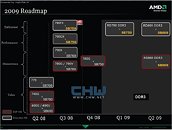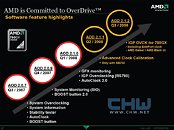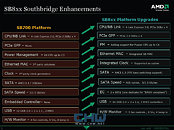Saturday, July 5th 2008

AMD Chipset Roadmap for 2009 Uncovered
As of today, AMD is close to over a year and a half behind Intel with the implementation of the DDR3 system memory standard, and it doesn't look like we are going to see a DDR3 AMD platform only until late this year or early next year. Chilian website CHW.net published slides of the roadmaps for AMD chipsets in the months to come, also published are slides refering to the details of the next generation southbridge by AMD, even though the latest entry, the SB700 is only teething and only the latest motherboards with 7-Series chipsets feature this.
The roadmap shows that the immediate entry into the market would be the AMD 790GX northbridge. Think of it as a fusion between 780G and 790X. Or better put, a 790X with an integrated graphics processor (IGP), or even better put, AMD's response to NVIDIA's flagship AM2+ chipset, the NForce 750a that supports SLI and also features an IGP. The companion southbridge, SB700 has come a tad-late into the market, we had expected 7-series chipset featured boards to come with this but it's known that a clock-generator fault was detected with early batches of the SB700 and AMD had recalled it before it could feature with premium 7-series boards, that's part of the reason why flagship 790FX boards such as ASUS M3A32-MVP Deluxe and Gigabyte GA-790FX-DQ6 featured the dated SB600 with an additional SATA controller for two or more extra SATA ports. We already find SB700 with some of the recent 780G boards.
The roadmap shows the presence of a SB750, which simply put is all the features of SB700 plus an added SATA RAID 5 mode along with the advanced clock caliberation support for Overdrive. This will feature only with the high-end 790FX and 790GX northbriges. Speaking of northbridge, a DDR3-'supportive' variant of the RD790 (AMD 790FX/GX) is slated for Q1 2009. By 'supportive', we mean that the boards this chipset features in have DDR3 or DDR3+DDR2 slots. It's important to note that memory standard compatibility is a function of the memory controller AMD processors (CPU) carry. On a AM3 board that features both DDR3 and DDR2 slots, you will be able to use both current Phenom processors and those future Phenoms with DDR3 support. The current Phenom processors will not work on boards with only the DDR3 slots since today's Phenom doesn't feature a DDR3 IMC.
An evolution of this northbridge would be the RD890 and RS880 which are slated for Q2 2009. These parts come with support for G3MX, that allows support for fully-buffered DRAM in its server/workstation variants. These northbridges are likely to be accompanied by a newer SB800 southbridge. The third slide provides insight into what edge this SB offers over the current SB700 series. The most important of them being an evolved 'A-Link'. A-Link is the chipset bus (that which connects the NB to SB) that AMD (formerly ATI) has been using since they entered the chipset business. Simply put, this is a 4-lane PCI-Express connection that offers 1000 MB/s (each direction) of bandwidth, that makes the SB a PCI-E device that connects to the PCI-E switch located in the northbridge. As times pass, with southbridges coming with as many as 14 USB 2.0 ports and 6 SATA ports, there has been an increasing need to expand this bus. Intel uses the age old Direct Media Interface in its current chipset, which apparently could be bottlenecking it even now. This can be advocated by the fact that in the D5400XS "Skulltrail", the NB connects to the SB using 4 PCI-E lanes as supplimentry connections apart from DMI. With QuickConnect however, things could change. NVIDIA uses a strong HyperTransport link as its chipset bus. With the SB800, the A-Link gets a revamp, the SB800 now connects to the system using PCI-E 2.0 x4, double the bandwidth.
AMD also plans to revamp its Overdrive system performance management software, with users and experts pointing out limits and flaws with its current model.
I will conclude my wrap on this roadmap saying that it looks impressive, lot of features that were begging to be added are in, but all that remains is that there has to be a good processor to go with all that. With newer processors on the cards, we have to hope for the best, and fear the worst (or wait for CHW to leak another set of slides so we could tell you more :-)With inputs from CHW
The roadmap shows that the immediate entry into the market would be the AMD 790GX northbridge. Think of it as a fusion between 780G and 790X. Or better put, a 790X with an integrated graphics processor (IGP), or even better put, AMD's response to NVIDIA's flagship AM2+ chipset, the NForce 750a that supports SLI and also features an IGP. The companion southbridge, SB700 has come a tad-late into the market, we had expected 7-series chipset featured boards to come with this but it's known that a clock-generator fault was detected with early batches of the SB700 and AMD had recalled it before it could feature with premium 7-series boards, that's part of the reason why flagship 790FX boards such as ASUS M3A32-MVP Deluxe and Gigabyte GA-790FX-DQ6 featured the dated SB600 with an additional SATA controller for two or more extra SATA ports. We already find SB700 with some of the recent 780G boards.
The roadmap shows the presence of a SB750, which simply put is all the features of SB700 plus an added SATA RAID 5 mode along with the advanced clock caliberation support for Overdrive. This will feature only with the high-end 790FX and 790GX northbriges. Speaking of northbridge, a DDR3-'supportive' variant of the RD790 (AMD 790FX/GX) is slated for Q1 2009. By 'supportive', we mean that the boards this chipset features in have DDR3 or DDR3+DDR2 slots. It's important to note that memory standard compatibility is a function of the memory controller AMD processors (CPU) carry. On a AM3 board that features both DDR3 and DDR2 slots, you will be able to use both current Phenom processors and those future Phenoms with DDR3 support. The current Phenom processors will not work on boards with only the DDR3 slots since today's Phenom doesn't feature a DDR3 IMC.
An evolution of this northbridge would be the RD890 and RS880 which are slated for Q2 2009. These parts come with support for G3MX, that allows support for fully-buffered DRAM in its server/workstation variants. These northbridges are likely to be accompanied by a newer SB800 southbridge. The third slide provides insight into what edge this SB offers over the current SB700 series. The most important of them being an evolved 'A-Link'. A-Link is the chipset bus (that which connects the NB to SB) that AMD (formerly ATI) has been using since they entered the chipset business. Simply put, this is a 4-lane PCI-Express connection that offers 1000 MB/s (each direction) of bandwidth, that makes the SB a PCI-E device that connects to the PCI-E switch located in the northbridge. As times pass, with southbridges coming with as many as 14 USB 2.0 ports and 6 SATA ports, there has been an increasing need to expand this bus. Intel uses the age old Direct Media Interface in its current chipset, which apparently could be bottlenecking it even now. This can be advocated by the fact that in the D5400XS "Skulltrail", the NB connects to the SB using 4 PCI-E lanes as supplimentry connections apart from DMI. With QuickConnect however, things could change. NVIDIA uses a strong HyperTransport link as its chipset bus. With the SB800, the A-Link gets a revamp, the SB800 now connects to the system using PCI-E 2.0 x4, double the bandwidth.
AMD also plans to revamp its Overdrive system performance management software, with users and experts pointing out limits and flaws with its current model.
I will conclude my wrap on this roadmap saying that it looks impressive, lot of features that were begging to be added are in, but all that remains is that there has to be a good processor to go with all that. With newer processors on the cards, we have to hope for the best, and fear the worst (or wait for CHW to leak another set of slides so we could tell you more :-)With inputs from CHW



28 Comments on AMD Chipset Roadmap for 2009 Uncovered
14 USB ports isn't a demerit. If some see it as PR crap, go on. It is PR crap, but it's not something to crib about. Additionally, AMD is too small an player to make major changes to the USB specifications and come up with 'double power' or altered polling rates.
And: put the darn USB behind us already!
In fact, different mainboards + chipsets provide subtly different power
specifications/capabilities, especially regarding Vbus droop.
With USB 1.0 let alone within USB 2.0 there are plenty of options for increasing the power available for any device.www.beyondlogic.org/usbnutshell/usb2.htm
www.usbpluspower.org/specs/index.jsp
www.usb.org/developers/usbfaq/#pow1
www.ibm.com/developerworks/power/library/pa-spec7.html